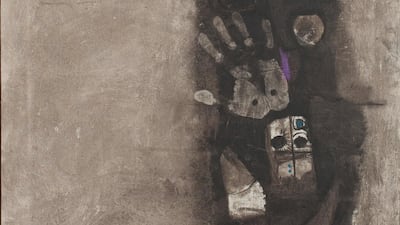There are artists whose work you think you know, and then something stops you in your tracks. So it was in A Century in Flux: Highlights from the Barjeel Art Collection at the Sharjah Art Museum, when I saw Dia Azzawi's Al-Jawf Masks in person. Dark in colour and sombre in tone, it's a great, brooding painting, with one exceedingly rare element: Azzawi's own handprint, pressed onto the canvas.
Azzawi painted Al-Jawf Masks in Iraq in 1966, three years after the Ba'ath Party coup and during a time of violent crackdown on poets and artists. Azzawi himself was imprisoned for three months, and a number of his works refer directly to the events of that time, such as A Wolf Howls: Memories of a Poet, which is also on show in the Barjeel exhibition. More impressionistic than that more famous painting, Al Jawf Masks is named after a village near Karbala – Qaryat al-Jawf – in the north of Iraq, where Azzawi had been stationed during military service. There he learnt from the peasants and local villagers of folkloric, mythological, and religious stories and motifs that appeared for years afterwards in his practice, combined into new narratives and protests alike. A number of these elements feature in Al-Jawf Masks, such as, in the centre of the canvas, a blue circle suggesting a traditional protective bead, or, just below, eyes that, following ancient Sumerian motifs, are painted black. The spirals on the top of the dark column replicate patterns from bisat, a kind of thick carpet made in Iraq.
And in the middle of the whole composition, you have that hand. What is it doing there?
Technically, it's a reference to the Hand of Fatima – a typical Shia symbol of protection, and one that appears in a few of the artist's other works. But Al-Jawf Masks is a particularly earthy, almost raw painting, and I couldn't stop thinking of what it must have been like for Azzawi to put his hand to the canvas like that. Particularly for a practice inspired by philosophy and ethnography, and known for clean lines and bright colours, it's a revelation to see this impure, imperfectly rendered, physical residue of skin and paint.
It’s a sudden appearance of the artist’s body: Here. I. Am.
It is not surprising that Azzawi, in those fraught political circumstances, would show a fragmented body, nor that he would surround it with protective symbols. In other works of the time, he likewise signalled how the human figure itself was under threat: the world around him was full of violence. But for me, this hand does more than that. It transforms the painting into a performance across time – and if you’ll permit a probably unexpected excursus, I’ll try and suggest why.
___________________
Read more:
The story behind Ai Weiwei's Fountain of Light at Louvre Abu Dhabi
In the frame: Basim Magdy, The Dent, 2014
Louvre Abu Dhabi 360: Check out the galleries from all angles
___________________
Handprints are relatively rare in painting, but they are important: they are some of the earliest known examples of art. Cave paintings have been discovered that date back to 40,000BC and show the outlines of human hands, in sites from southern France to Australia to Indonesia. For one kind of hand painting, Paleolithic humans would blow pigment around their hands, covering the cave wall with manifold stencils.
These works have been understood as some of the first attempts at mark-making and even self-portraiture. Another theory, which is more important here, moves away from the metaphor of proto-canvas and representation, and wonders: what if the ancient humans held their hands up to the damp cave walls and thought of them as membranes to another world? Their pigment-blowing could be the remnant of a ritual that allowed them to access another side – the world of their ancestors, perhaps, or that of the future.
Perhaps because Al-Jawf Masks' handprint speaks of the artist so immediately, and seems so plaintive amid the tragic composition, I can only think of this painting as doing something similar: a literal reaching out to the audience seeing the work, in a different, perhaps happier time. And for our part – do we have what it takes to meet this connection from beyond the museum wall?


